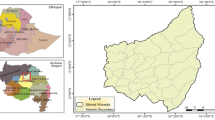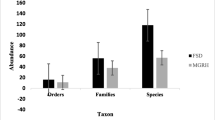Abstract
Soil fauna have been receiving more and more attention because they play an important role in nutrient cycling. However, there is a lack of information on soil arthropods in the forest-steppe ecotone in the mountainous region of northern Hebei, which makes it difficult to meet the need of protecting biodiversity in this area. Soil arthropod communities were investigated in the forest-steppe ecotone in northern Hebei province to provide basic information on changes in mountain soil fertility, which could promote the development of soil arthropod communities in mountain ecotones. From the preliminary identification, a total of 7994 individual soil arthropods were collected, which belonged to 25 groups, 6 classes and 24 orders. Acarina, Hymenoptera and Collembola were the dominant groups in the ecotone. The number of Acarina was higher than Collembola, and this phenomenon was obviously different from other areas in the same climate zone. The increased abundance of rare groups in the Forest zone with the richer vegetation, higher arthropod abundance and more substantial litter depth, could be interpreted as a reaction to the suitable soil environment and food supply. And these rare groups were sensitive to environmental changes, which could be regarded as biotic indicators for evaluating soil quality. The analysis of community diversity showed that the abundance index (d), the Shannon-Wiener index (H′), the evenness index (J) and the density-group index (DG) were significantly higher in the forest zone, lower in the forest-steppe zone, and lowest in the meadow-steppe zone. Seasonal variations in community composition correlated with changes in average air temperature and precipitation in this ecotone. Groups and individuals of soil arthropod communities in the three zones were present in greater numbers in the middle of the rainy season than in the early or late periods of the rainy season as a whole. At the same time, seasonal changes in soil arthropod communities from different plots were also influenced by habitat condition.
Similar content being viewed by others
References
Boyda S. E., Rees H. L. and Richardson C. A. 2000. Nematodes as Sensitive Indicators of Change at Dredged Material Disposal Sites. Estuarine, Coastal and Shelf Science 51: 805–819.
CHEN Xudong and ZHAO Yuxing, 1998. The Determination of Ecotone and the Chatracteristics of Biome on Ordos Plateau. Acta. Phytoecologica Sinica 22(4): 312–318.
Dicastri F and Hansen A.J. 1992. The Environment and Development Crises as Determinants of Landscape Dynamics. In: Hansen, AJ. Landscape Boundaries, New York: Springer-Verlag pp.3–18.
De Goede and R.G.M. 1996. Effects of Sod-Cutting on the Nematode Community of a Secondary Forest of Pinus SylvestrisL. Biology and Fertility of Soils 22: 227–236.
Ettema, C.H., Coleman, D.C. and Vellidis, G. et al. 1998. Spatiotemporal Distribution of Bacterivorous Nematodes and Soil Resources in a Restored Riparian Wetland. Ecology 79: 2721–2734.
Freckman, D.W. and Ettema, C.H. 1993. Assessing Nematode Communities in Agro-ecosystems of Varying Human Intervention. Agriculture Ecosystem and Environment 45: 239–261.
Freckman, D.W. and Virginia, R.A. 1997. Low Diversity Antarctic Soil Nematode Communities: Distribution and Response to Disturbance. Ecology 78: 363–369.
Forman R. T. and Moore P. N. 1992. Theoretical Foundations for Understanding Boundaries in Landscape Mosaics. In: Hansen A J, Landscape Boundaries; Consequences for Biotic Diversity and Ecological Flows, New York: Springer-Verlag pp. 236–258.
Gregor W and Yeates G. W. 2003. Nematodes as Soil Indicators: Functional and Biodiversity Aspects. Biology and Fertility of Soils 37: 199–210.
Gosz J. R. 1992. Ecological Functions in a Biome Transition Zone: Translating Local Responses to Broad Scale Dynamics. In: Hansen, AJ. Landscape Boundaries, New York: Springer-Verlag pp.56–74.
Gates J. E and Gysel L W. 1978. Avian Nest Dispersion and Fledging Success in Field-Forest Ecotones. Ecology 59(5): 871–881.
Holland, M.M.and Risser, P. G. 1991. Ecotones: The Role of Landscape Boundaries in the Management and Restoration of Changing Environments. Chapman & all, New York pp.1–142.
James C. N, Walter G. W and Marek K, 1996. Soil Land Litter Micro Arthropod Populations from Two Contrasting Ecosystems in Semi-arid Eastern Australia. Journal of Arid Environments 32: 329–346.
Nahmani J. and Lavelle P. 2002. Effects of Heavy Metal Pollution on Soil Macrofauna in Grassland of Northern France. European Journal of Soil Biology 38:297–300.
Ekschmitt K., Bakonyi G., Bongers M. 2001. Nematode Community Structure as Indicator of Soil Functioning in European Grassland Soils. European Journal of Soil Biology 37: 263–268.
Lubchenco J. 1992. The Sustainable Biosphere Initiative: An Ecological Research Agenda-A Report from the Ecological Society of American. Ecology 72(2): 371–412.
Lavrenko E.M and Karamysheva Z.V. 1993. Steppes of the Former Soviet Union and Mongolia. In: Coupland R T, Natural Grassland-eastern Hemisphere and Resume. Ecosystems of the world Vol.8B. The Nether Land, Amsterdam pp. 156–177.
LIAO Chonghui and LI Jianxiong. 2000. The Community Structure of Soil Animal in the Tropics and Subtropics of China. In: Yin Wenying et al., Soil Animal of China. Beijing: SciencePress pp. 77–99. (In Chinese)
LIAO Chonghui, LI Jianxiong and HUANG Haitao. 1997. Soil Animal Community Diversity in the Forest of the Southern Subtropical Region, China. Acta Ecologica Sinica 17(5): 549–545. (In Chinese)
LU Youcheng and WANG Zongying. 1994. Vertical Distribution of Soil Animal on the Jiuhua Mountain. Geographical Research 13(2): 74–81. (In Chinese)
MA Shijun. 1990. Modern Ecology. Beijing: Science Press pp.43–45. (In Chinese)
Sadaka N. and Ponge J.F. 2003. Soil Animal Communities in Holm Oak Forests: Influence of Horizon, Altitude and Year. European Journal of Soil Biology 39:197–207.
Raghubanshi A.S, Srivastava S.C and Singh R.S. 1990. Nutrient Release in Leaf Litter. Nature 227–346.
Richard D., Bardgetta and Roger Cook. 1998. Functional Aspects of Soil Animal Diversity in Agricultural Grasslands. Applied Soil Ecology 10: 263–276.
SUN Ruiyong. 2001. Animal Ecological Principle. Beijing: Beijing Teacher University Press pp.393–394. (In Chinese)
Terborgh J. 1985. The Role of Ecotones in the Distribution of Andean Bird. Ecology 66(4):1237–1246.
Walt H. 1984. World Vegetation-Ecosystem of Land Biosphere. Beijing: Science Press pp.5, 75,100,147,214,281.
Wasilewska L. 1998. Soil Invertebrates as Bio-indicators, with Special Reference to Soil Inhabiting Nematodes. Russian Journal of Nematology 5: 113–126.
WANG Qingsuo, FENG Zongwei and LUO Juchun. 2000. Biodiversity of a Forest-steppe Ecotone in Northern HeBei Province and Eastern Inner Mongolia. Acta Phytoecologica Sinica 24(2): 141–146. (In Chinese)
WANG Qingsuo, LIU Tao and FENG Zongwei, et al. 2001. Study on Plant Diversity of betula platyphylla and populous Dravidian Forest in Forest-Steppe Ecotone. Sientia Silvae Sinicae 24(2): 141–146. (In Chinese)
WANG Qingsuo. 2004. Forest Landscape Spatial Patterns of Forest-Steppe Ecotone in Northern Hebei Province and Eastern Inner Mongolia. Chinese Journal of Ecology 23(3): 11–15. (In Chinese)
YANG Xiaodong. 2003. Comparison of the Communities Structure and Seasonal Changes in Diversity of Soil Arthropod in Tropical Secondary Forest, Dry-rice Land and Fired Remains, Acta Ecologica Sinca, 23(5): 883–891. (In Chinese)
Yeates, G.W. and Bird, A.F., 1994. Some Observation on the Influence of Agricultural Practices on the Nematode Fauna of Some South Australian Soils. Fundam. Appl. Nematol 17: 13–145.
YIN Wenying. 1998. Pictorial Keys to Soil Animals of China. Beijing: Science Press. (In Chinese)
YIN Wenying. 1992. Chinese Sub-tropical Soil Animal. Beijing: Science Press pp.7–557. (In Chinese)
YIN Wenying. 2000. Soil Animals of China. Beijing: Science Press, 77–100. (In Chinese)
ZHENG Leyi and GUI Hong. 1999. Insect Classification, Nanjing Normal University Press pp. 68–75. (In Chinese)
Author information
Authors and Affiliations
Corresponding author
Rights and permissions
About this article
Cite this article
Zhu, X., Gao, B., Yuan, S. et al. Community structure and seasonal variation of soil arthropods in the forest-steppe ecotone of the mountainous region in Northern Hebei, China. J. Mt. Sci. 7, 187–196 (2010). https://doi.org/10.1007/s11629-010-0198-0
Received:
Accepted:
Published:
Issue Date:
DOI: https://doi.org/10.1007/s11629-010-0198-0




